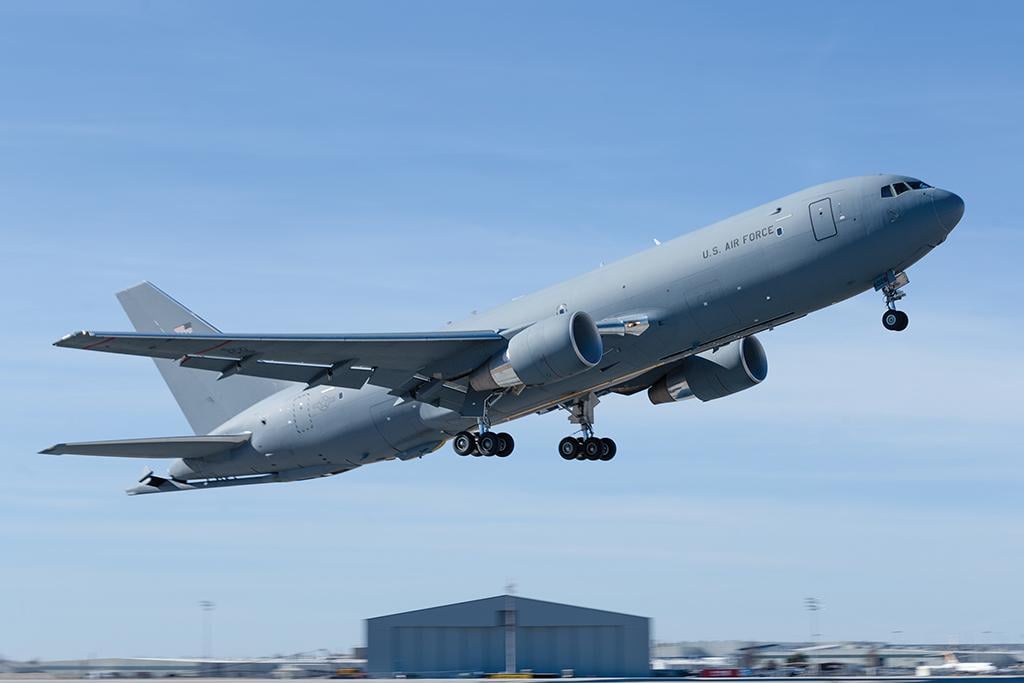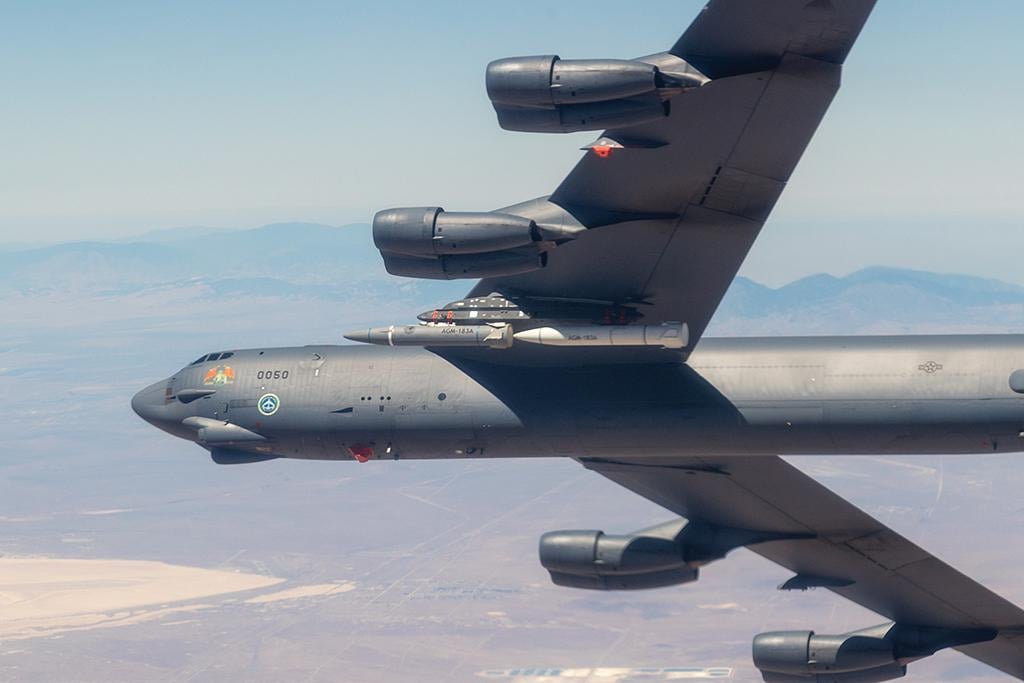
B-21 Raider.
As the U.S. Air Force celebrates its 75th anniversary, the service is in the middle of several major modernization efforts to reshape it for a fight against a peer nation. These efforts include a new stealth bomber and fighter, next-generation munitions and the first new ICBM in more than 50 years. Here is a selection of key programs that will shape the Air Force’s future.
B-21 Raider
The Northrop Grumman B-21 Raider will be the U.S. Air Force’s next generation, long-range stealth bomber, replacing the company’s B-2 Spirit and the Rockwell B-1B Lancer. The Air Force and Northrop now expect the public rollout of the bomber to take place this year, ahead of its first flight next year. Six of the aircraft are in production at the secretive Plant 42 complex in Palmdale, California, and the first airframe recently completed loads calibration testing. The service expects to field at least 100 of the bombers at three bases—Ellsworth AFB, South Dakota; Dyess AFB, Texas; and Whiteman AFB, Missouri—to fly alongside modernized Boeing B-52 Stratofortresses. The Air Force is increasing its spending on the project to $3.3 billion in research, development, test and evaluation funding, along with $1.8 billion for procurement. The latter will rise to $19.5 billion in the next five years, according to budget documents.
Next-Generation Air Dominance
The most important modernization project in the Air Force’s tactical aircraft portfolio is also its most secretive, with limited on-the-record information about the sixth-generation fighter that will replace the Lockheed Martin F-22 Raptor. Recent contract announcements for the engine that will power the Next-Generation Air Dominance (NGAD) aircraft show that there are still three major players in the running to build an air-craft—Boeing, Lockheed Martin and Northrop Grumman. Air Force Secretary Frank Kendall told lawmakers this year that the project has moved to engineering and manufacturing development but did not provide additional details. His statement came about two years after former Air Force acquisition head Will Roper disclosed that an NGAD flight demonstrator had flown. Kendall said the NGAD system will be expensive, costing “hundreds of millions of dollars” each, in addition to the development of an also costly uncrewed Collaborative Combat Aircraft to fly alongside the stealth fighter.
F-35A

The Air Force has slowed procurement of the Lockheed Martin F-35A amid supply chain issues, contract negotiations and plodding development of a much-needed technological upgrade. The service’s fiscal 2023 budget proposal calls for the purchase of 48 of the aircraft, below the expected 60. The biggest reason for the reduction is the schedule for the Block 4 follow--on modernization program and dissatisfaction with the progress of the anticipated Technology Refresh 3 processor, though the service says the procurement numbers in future years will increase once the upgrades are ready. “I’ve had people ask me if we’re committed to the F-35. Of course we’re committed to the F-35,” Kendall said. “We’re 15 years into production, and we’ll be building F-35s probably another 15 years.” These upgrades will require a significant increase in power and cooling beyond what the current Pratt & Whitney F135 powerplant can provide, and the service has been considering a major F135 upgrade or Pratt and GE Aviation’s engines in development under the Adaptive Engine Transition Program for potential reengining. Kendall plans to make a decision on the matter by next spring when the next budget proposal is rolled out.
F-15EX

The service has also changed its approach to procuring Boeing’s new F-15EX Eagle II, a modernized version of the F-15 largely based on the F-15QA variant developed for Qatar. The F-15EX and the selected GE Aviation F110-GE-129 engines will allow the F-15EX to carry more weapons. The advanced BAE Systems Eagle Passive Active Warning Survivability System will provide advanced radar warning, jamming and countermeasures. The service has announced plans to reduce its purchases of the aircraft to 24 in 2023 and to end procurement at 80—a significant drop from the originally planned 144. The F-15EXs were planned to replace more than 200 F-15C/Ds, but the reduced fleet would cover only training jets and existing squadrons in Oregon and Okinawa, Japan. Two F-15EXs are undergoing simultaneous developmental and operational testing.
T-7A

Boeing’s T-7A Red Hawk will be the service’s next-generation trainer for fighter pilots, set to replace the aging Northrop T-38C Talon II. The jet has faced delays due to COVID-19-pandemic-related issues and supply chain shortages, ahead of an expected full-rate production decision in mid-2023 and initial operational capability in 2024. Boeing publicly rolled out the trainer in April, with its now-signature red tail—an homage to the Tuskegee Airmen. The company has touted its digital engineering on the project, which allowed it to quickly and accurately produce the jet in its St. Louis facility, where it marries Saab’s fuselage, GE’s F404 engines and other components, including a unique cockpit with “stadium” seating for a student and instructor, and advanced avionics. The cockpit has presented an issue and has been redesigned after testing showed weak-nesses in the event of a bird-strike. The Air Force is for the first time requesting procurement funding for the T-7, with just $10.5 million in advanced procurement. That will increase to $321.9 million in 2024, when the service wants to buy 14 of the jets. The Air Force plans to field up to 475 Red Hawks.
Tankers

The Air Force’s next-generation tanker, the Boeing KC-46A Pegasus, has been notorious for development issues as the service brings on the Boeing 767-based refueler. As of August, the Air Force had received 61 of the jets but still awaits initial operational capability, set for 2024. The biggest issue has been the problematic Remote Vision System—the collection of cameras, sensors and screens connecting the boom operator in the front of the jet with the refueling system at the back. The system as designed is the source of multiple critical deficiencies and is being completely revamped, with the critical design review expected to close this fall. The Air Force plans to purchase 179 of the KC-46s through 2029 and is looking at multiple routes to modernize the rest of the fleet. The first route, the KC-Y “Bridge Tanker,” would be a competition between an upgraded KC-46 and the Lockheed Martin LMXT—a modified Airbus A330 Multi-Role Tanker Transport. Air Force leaders say, however, that as requirements are refined, a competition is looking less likely, with a final decision on how to proceed expected next spring. Beyond that, the service is accelerating its next-generation “KC-Z,” with a preliminary analysis of alternatives planned to start in 2024—well ahead of its original schedule of 2030. This aircraft is expected to be more of a leap ahead in technology, bringing on autonomy and potential stealth characteristics.
Sentinel

The recently renamed LGM-35A Sentinel, formerly known as the Ground-Based Strategic Deterrent, is Northrop Grumman’s replacement for the Minuteman III ICBM system. North-rop won the $13.3 billion contract for the missiles and related systems in 2020 with a plan for initial operational capability by 2029 and for it to remain in service until 2075. The first flight tests of the system are expected next year, and initial production is slated for 2026. The system includes several new components, including a silo modernization and the Lockheed Martin Mk21A reentry vehicle that will carry the new W87-1 warhead developed by the National Nuclear Security Administration.
AIM-260 JATM

Like NGAD in the fighter arena, the Air Force’s biggest step forward in air-to-air missiles is also highly classified. The Lockheed Martin AIM-260 Joint Advanced Tactical Missile (JATM) will be the replacement to the AIM-120 Advanced Medium-Range Air-to-Air Missile (Amraam) and fly at much greater ranges. Since the system was first announced in 2019, the Air Force has been highly secretive about its progress. In a speech in December, Kendall said the JATM is one of the service’s highest priorities. But he declined to offer any updates in a recent interview with Aviation Week, citing operational security concerns. In announcing the program in 2019, an official at the Air Force Life Cycle Management Center said the JATM was expected to fly on an F-22 in 2021 and be operational in 2022. It is being developed as a counter to China’s long-range PL-15 air-to-air missile, which service officials are concerned could “out-stick” an F-22 with Amraams. However, Raytheon said in July that its new AIM-120D3 has flown farther than the estimated range of the PL-15 because of upgrades from its Form, Fit and Function Refresh program.
Long-Range Standoff Missile
Raytheon is building the nuclear AGM-181A Long-Range Standoff (LRSO) cruise missile to replace the Boeing AGM-86 Air-Launched Cruise Missile, with a $2 billion contract awarded in July 2021 for engineering and manufacturing development. Air Force budget documents say the LRSO will be fielded on both legacy (B-52) and future (B-21) bomber aircraft and is expected to be capable of penetrating and surviving advanced Integrated Air Defense Systems. The program is undergoing development, verification and test activities for design maturation ahead of a critical design review. The service requested $928.9 million in fiscal 2023 for research, development, test and modification, with a total of $6.45 billion planned over the next five years. Initial operational capability is expected by 2030, with more than 1,000 of the missiles planned, according to the Congressional Budget Office. It will be armed with an upgraded W80-4 warhead. Few other details about the LRSO have been released, leaving undisclosed whether it is subsonic or faster, very stealthy or not.
Hypersonic Missiles

The Air Force is “riding two horses” on its main hypersonic development efforts, according to Air Force Materiel Command chief Gen. Duke Richardson. The first is the Lockheed Martin AGM-183A Air-Launched Rapid Response Weapon (ARRW), which faces an uncertain future following a series of test failures this year. However, two successful booster tests and the first glider test planned in the near future have the service more hopeful about its prospects. The Air Force’s budget plans shifted funding away from procurement to research, development, test and evaluation funding after the test failures—Kendall said the program needed to prove itself. While ARRW development is further along, the service is also developing the two-stage scramjet-powered Hypersonic Attack Cruise Missile as a follow-on to the Hypersonic Air-Breathing Weapon Concept to combine Air Force and DARPA-developed technologies. The Air Force wants $317 million in 2023 for development of the program.
Editor's note: This was updated to correct the GE engine chosen for the F-15EX aircraft.




Comments
Bernard Biales